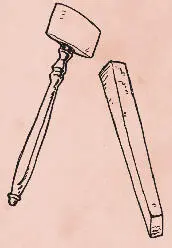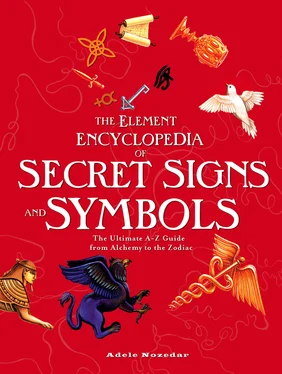However, although Hiram was effectively dead, his memory lives on and so effectively he is reborn. The initiation of the grade of Master Mason re-enacts the ritual of the death of Hiram. In as much as there are any hard and fast rules which apply to the symbolism inherent within Freemasonry, the three blows symbolize three different kinds of death: the death of the body (the blow to the throat), the death of the feelings (the strike on the chest), and the death of the mind (the blow to the forehead). Thus, the would-be Master Mason leaves his old self behind, the initiatory process symbolizing his rebirth into the higher moral values that were held by Hiram, of integrity, knowledge, and detachment. In other words, the mason is reborn as a better individual, having risen above the ignorance, hypocrisy, and envy personalized by his murderers.

The hammer, in use at Masonic meetings, is not used simply to gain the attention of the gathering. Effectively, it represents the powers of the intellect that drive the thoughts and the will of the individual. At Lodge meetings, the hammer is the symbol of the authority of the Worshipful Master who presides over the meeting.
The chisel is only useful if it is directed by the will of the hammer, and so represents the intellect and finer discernment.

Again, the level and the plumbline attached to it are inseparable items of practical building equipment that serve a deeper symbolic meaning within Freemasonry. The level comprises a set square, from the center of which hangs the plumbline. The plumbline is used to define both the vertical and horizontal lines, so it takes on the symbolism of the cross, too. The vertical level symbolizes the apprentice, and the horizontal, the degree of Fellowcraft.
It is also worth bearing in mind the philosophical meanings of the word “level,” meaning steady and honest, as well as its practical application as a tool. These two meanings are inextricably linked from the actual symbol of the tool itself.
Correct measurements, defined by the rule, are essential to the physical construction of a building, and ensure that the design concept will work in the real world. Also of significance are the degrees of measurement that are depicted on the actual ruler itself; in the imperial measurements, these degrees of 12 and 24 correspond to the daily cycle of the Sun. In this sense, the rule represents the macrocosm. The rule also keeps everything in order, and acts as a guide.
To Freemasons, the triangle symbolizes the Greek capital D, which they call the “shining Delta.” The triangle also indicates the meanings of things in triplicate, such as “right thinking, right speaking, and right doing.” On a microcosmic scale, the base of the triangle represents duration, and the two sides symbolize the qualities of light and darkness, male and female, etc. Possibly the most famous symbolic use of the Masonic triangle—which traditionally has an angle of 36 degrees at the apex and two angles of 72 degrees at the base—is the one that includes a blazing star and also a pentagram as seen on the Seal of the United States and on the United States dollar.
10. TRACING BOARD OR TRESTLE BOARD
As with many of the symbols inherent within Freemasonry, the tracing board itself is a symbolic representation of an important piece of practical equipment used in masonry.
The tracing, or trestle, board has its origins in the flat piece of wood or cloth that was used as a drawing board by the Master Mason, on which he sketched the dia-grams, schemes, and measurements needed for the building work in question. Initially represented as a piece of cloth which was rolled out on the floor at the beginning of a Masonic meeting, the tracing board is now a piece of wood that contains the signs and symbols relevant to the Brothers within their degrees of Masonic hierarchy. The boards are elaborate works of art, with the symbols woven into the whole in a pictorial, allegorical way. The symbols that are already mentioned in this section all take their place. The seemingly simple builders’ tools serve to remind the initiate of their more esoteric spiritual meanings that amount to the betterment of the person and personal enlightenment.
There are hundreds, if not thousands, of different sorts of tracing boards, all usually the work of individual artists. Different tracing boards show the different degrees of the Craft.
As well as showing pictures of the tools involved with practical masonry, tracing boards might tell the story of Hiram Abiff’s murder or perhaps show pictures of the ritual re-enactment of this crime as part of initiation ceremonies. Tracing boards also represent features of the actual temple: the pillars, the checkerboard floor, the porch with its two columns.
The humble apron of the working Mason is elevated to almost religious status by the Freemasons. Generally made of leather, the way the apron is worn symbolizes the status of its wearer, with the bib worn up for the apprentice, or down by superior grades. Wearing the apron is representative of work and the necessity to be busy and industrious, and also of the fig leaves worn by Adam and Eve; as such the apron preserves the modesty of the wearer. Like the tracing board, the Masonic apron has the signs and symbols of the Craft embroidered on it.
One of the most famous of the many Masonic aprons is that which belonged to George Washington. Given to him in 1784 by the Marquis de Lafeyette whose wife embroidered the apron, it displays many Masonic symbols. Nothing is left to chance; the border colors of red, white, and blue are not only the national colors of France but also of the USA. Other symbols on this historic apron include:
the All Seeing Eye—
watchfulness, the Supreme Being;
rays—show the power of the Supreme Being to reach inside the hearts of men;
rainbow—symbolic of the arch of Solomon’s Temple that is supported by the two pillars, Jachim and Boaz;
Moon—the female principle;
globes on top of pillars—peace and plenty;
the three tapers—symbolize the three stages of the Sun; rising in the East, in the Southern sky at noon, and setting in the West;
trowel—symbolic of spreading love and affection, the “cement” that binds the Brothers of Freemasonry;
five-pointed star—represents friendship;
checkered pavement—often a feature of temples and again is based on the floor of Solomon’s original temple and represents the duality of opposites, male and female, and so on;
steps—represent the degrees of masonry;
coffin—represents death and therefore rebirth and is a recurrent motif in Freemasonry;
skull and crossbones—symbols of mortality but also of rebirth;
acacia;
compasses;
the square and level;
the ark—safety and refuge;
tassel and knot—the ties that bind the Brothers;
the Sun—the Light of God, the male principle;
sword and heart—symbolic of justice being done; nothing can be hidden from the eyes of the Great Architect;
seven six-pointed stars—here, seven stands for the seven liberal arts and sciences;
beehive—a symbol of industry and a reminder that man should be rational and industrious at the same time.
Читать дальше














